Text
ɴᴏᴡ ᴘʟᴀʏɪɴɢ: Fireflies by Owl City
───────────────⚪───────────────────
◄◄⠀▐▐ ⠀►►⠀⠀ ⠀ 1:17 / 3:48 ⠀ ───○ 🔊⠀ ᴴᴰ ⚙ ❐ ⊏⊐


Can you believe that these glowing light in the waters are sea fireflies? Everything is indeed never as it seems.
I bet you were awestruck[cod]!
Now, these millions of sea fireflies would like to wave “Hi!” as you go through the blog and get to know the bioluminescent ostracods under genus Vargula.
CLASSIFICATION
Kingdom: Animalia
Subkingdom: Bilateria
Infrakingdom: Protostomia
Superphylum: Ecdysozoa
Phylum: Arthropoda
Subphylum: Crustacea
Class: Ostracoda
Subclass: Myodocopa
Order: Myodocopida
Suborder: Myodocopina
Superfamily: Cypridinoidea
Family: Cypridinidae
Genus: Vargula
Species Name: Vargula annecohenae
(ITIS nd ; Cohen and Morin, 2010)
BIOLOGY
Cod you see me?

Ostracods can be found in basically every aquatic environment ranging from marine, freshwater, and estuarine habitats. These organisms are either swimming in the surface waters or crawling on the sea bed and moist land. Their distribution depends on their adaptations to environmental parameters, mainly salinity and water temperature. Vargula species inhabit the Pacific Ocean and Caribbean Sea coastal landmasses (Wilkinson, 1996; Ogoh & Ohmiya, 2005).
Although they are everywhere, ostracods rarely grow to a few millimeters long; small but (Pechenik, 2015). A single organism can’t be easily seen unless we look closely. Still, they’re small but widespread.
What do you mistake me as?
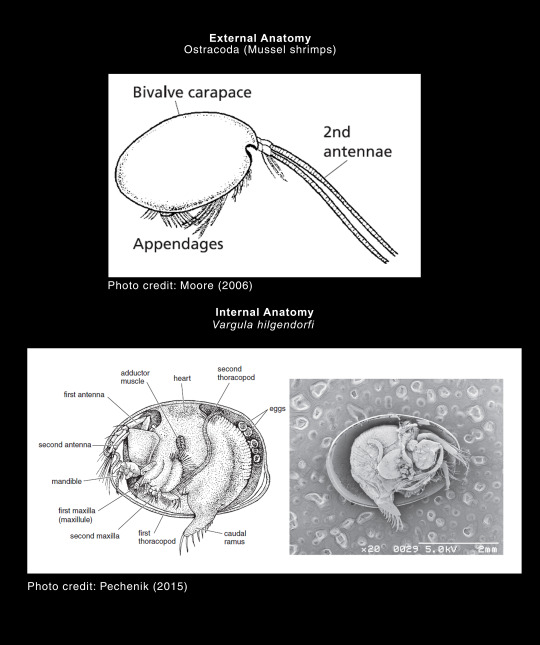
Ostracoda is an ancient group of crustaceans. Surprised?
The unsegmented external feature separates them from other crustaceans (Pechenik, 2015). Besides this, they resemble bivalves by having their entire body laterally enclosed inside a pair of partially calcified carapace or shells held by adductor muscles, even during early development; hence, the common name — mussel shrimp (Moore, 2006).

They are also similar to branchiopods Conchostraca (clam shrimps) such as water fleas, but the appendages, lack of growth rings, and smooth swimming of mussel shrimps gave it away. Another feature that differentiates both is the carapace formation. Clam shrimps add material to their carapace as they grow, while mussel shrimps shed their carapace with each molt (UC Museum of Paleontology, 1995).

Mussel shrimps are mostly head which means that the other body parts are greatly reduced. Their trunk is merged to the head. Usually, they have seven pairs of appendages adapted for locomotion, grasping, feeding, cleaning the carapace, or as sense organs. Vargula uses two pairs of antennae for swimming, some species only utilize one pair or the other. Notably, they have setae or tiny hairs protruding through the carapace pores that function for sensory mechanisms (Wilkinson, 1996; Pechenik, 2015).
youtube
A light show to remember
Bioluminescence is often used, but only by males of the species V. annecohenae, for mating displays. Males of each species, like fireflies on land, use distinct patterns of light flashes (seen as a series of dots) that only attract females of the same species. By performing brief dances in which they release short bursts of light as they pass towards the surface of the water, males show off just how sparkling they can be. They start their "dance," which lasts 45 minutes on average, with a stationary period in which brief (second-long or shorter) flashes of bright blue light are produced, attracting the interest of possible female mates. Then in the next process, males spiral up the water column vertically, producing quicker light bursts that are less bright (Gonzales, 2017).

(Courtesy of Gretchen Gerrish)
We compete to procreate
The male grabs onto his newfound partner with his antennae if a male is successful and an interested female arrives, and the pair will mate. Competition is intense, sometimes a woman's attention is won by the brightest male, but males can also impress by synchronizing their lighting display with other males or creeping up and taking a mate from another male (Gonzales,2017).
Life cycle
V. annecohenae has a long life cycle of up to about 1 year. It typically develops slowly for 3 months before adulthood. It has several broods of a few offspring numbering between 10-15, and has no free-living larval stage (Gerrish and Morin, 2008).
Five juvenile instars constitute the life cycle of Photeros annecohenae The life cycle of an ostracod in the genus Vargula (now Photeros) are divided by molts (that occur by the ecdysis) as well as an adult instar that is followed by a final molt (Gerrish and Morin, 2008).

The total growth period of ostracod eggs and embryos in females was 26 days, with an average of 7.84 days for the interval between mating and brood deposition, and an average of 18.4 days for the eventual release from the brood chamber. Eggs initially become evident within the female's body during development. While inside the mother's body, eggs increase in size but exhibit no other noticeable morphological changes. Females discharge fertilized embryos as translucent, spheroidal, or ovoidal masses into the marsupium or brood chamber (Gerrish and Morin, 2008).
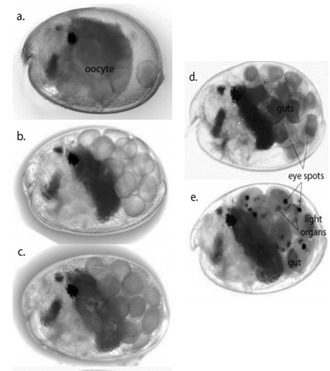
(a) One egg of this female has been released into the marsupium and the four remaining eggs are visible in the female ovary. (b) The eggs are extruded into a marsupial brood pouch after 7-8 days. Each egg consists of a large yolk mass at this stage, and the cells inside are barely visible. C) Cell division has created a defined, cloudy cellular mass that fills the egg by day nine in the brood pouch. D) The first apparent structures include the naupliar eye, a red speck, and the intestine as the embryo develops its organs. E) The embryos appear as A-V instars with a large brown eye spot and a fully developed and functioning light organ just before release (Gerrish and Morin, 2008).
I have a sperm bank?
Female V. annecohenae can produce several broods without male re-exposure. suggesting that sperm is stored between broods (Gerrish and Morin, 2008).

I’m a natural
15-17 days after a previous cohort was released new broods can be formed (Gerrish and Morin, 2008).

ECOLOGY
youtube
Ostracods are considered to be useful paleoenvironmental indicators because their ecology is often reflected in the shape and structure of their carapaces and also considering their wide distribution in aquatic environments. They can range from warm waters of the tropics to very cold environments such as polar seas and are found from intertidal zones to many thousands of meters depth in the deep sea. They can also thrive in freshwater niches such as rivers, lakes, and even temporary ponds (Brandão & Karanovic, 2020). Generally, ostracods are characterized as omnivorous scavengers because they mainly feed on tiny organisms like algae, diatoms, bacteria, molds, and pieces of organic detritus that are present in the water or on vegetation. Some ostracods are also predatory. Being relatively smaller, they attack their prey in groups so that they can eat organisms larger than them. However, ostracods are also often preyed by small fishes (MESA, 2020).
youtube
Freshwater ostracods usually have smooth, thin, weakly calcified simple bean-shaped carapaces and feed on diatoms, bacteria, and detritus. On the other hand, pelagic ostracods may also have thin, smooth shells but they have long powerful swimming appendages or antennules. The formation of rostral incisures at the anterior of the carapace of pelagic ostracods allowed freer movement of these appendages. Furthermore, benthic ostracods are commonly detritivores or filter feeders. Their carapace is usually smooth, small, robust, and sometimes elongated because they tend to burrow into the substrate. Epifaunal ostracods have flattened ventral surfaces sometimes with projecting alar wings, frills, keels, or lateral spines while those found on coarser substrates in higher energy environments tend to have more robust heavily ribbed or reticulated carapaces (Olney, 2002).
RELATIONSHIP TO HUMANS
Generally, ostracods are useful for scientific purposes. According to Boomer et al. (2013), ostracods are being used in studies of earth science and related disciplines such as archaeology, ecology, and genetics. This is because ostracods are widely distributed and are easily preservable. Their assemblage and morphology are some of the important ecological proxies. For instance, in recent research conducted by McCormack et al. (2018) wherein ostracods are being used as a bioindicator. Their research has shown the sensitivity of ostracods’ faunal assemblage (Candona sp.) to changes in water salinity and alkalinity in Lake Van.
Next, valves of ostracods are also being used in paleoenvironmental studies. Valves of ostracods are said to absorb trace elements from host waters (Palacios-Fest et al., 1994). This characteristic makes these microcrustaceans ideal models for reconstructing and analyzing past environments that could range from deep-seas to small lakes. Aside from this, the diversity and variety of reproductive modes of ostracods are also one of the main reasons why they are being used as model organisms for laboratory and research studies (Martens & Hornes, 2009).

Moreover, laboratories have started culturing bioluminescent ostracods. The culture of these organisms is done to determine the biosynthetic pathways of bioluminescent substrates that could lead to the discovery of new tools for biotechnology and biomedicine. For instance, in the study conducted by Goodheart et al. (2019) wherein they cultured California Sea Firefly (V. tsuji) for studies regarding the biosynthetic pathway of cypridinid luciferin and genomic manipulation of an autogenic bioluminescent system.
youtube
Serve the Teaaaaa!
The T in Osctracod means Teaaaaa! 5 amazing facts you need to know about ostracods.
1. OLD BUT GOLD

Colymbosathon ecplecticos, a species of ostracod, holds the record of oldest known fossil penis. The historical penis was discovered from a 425 million-year-old rock in England. It was said that a wide variety of animals living in the sea 425 million years ago were killed by an ash fall from a volcanic eruption. However, the ash preserved the animals, including their soft parts. Through technology, the painstaking 3-D reconstructions of a preserved male ostracod revealed amazing details such as the hairs on limbs, gills, and a penis.
2. LIGHT IT UP LIKE A DYNAMITE
youtube
Some species of Myodocopida ostracods produce a bright blue light. These are known in Japan as Umi-Hotaru or sea-fireflies. The light is produced by mixing two chemicals together in the presence of oxygen and is for mating displays. Each species flash at different rates to stop any confusion in the dark. Japanese army collected Umi-Hotaru in baited traps during the Second World War. They dry them out and ground them down to a powder. Adding a small amount of water to the powder produces a low-intensity light used by soldiers to read orders or maps without giving their position away to the enemy during battles.
3. ULTIMATE SURVIVOR

Ostracods can survive being eaten by fish. Experiments with the ostracod Cypridopsis vidua showed that 26% of specimens eaten by small bluegill sunfish came out the other end alive and unharmed. This is possible because ostracods can close their shells very tightly inside their carapace to survive passage through the gut of the fish eventually to be excreted out by the fish.
4. OSTRACODS ARE OMNIPRESENT

Ostracods are found in almost every aquatic habitat, even in some very small and isolated places. They are found deep in the sea, on the shore, on wet leaf litters, springs, groundwaters, puddles, small pools, rice fields, ponds, lakes, and rivers. Some species have a global distribution and are found from the subarctic to the tropics. Their dispersal abilities caused this massive distribution of ostracods. For example, the eggs and adults can hitch a lift on the feet of birds and are displaced because of migration.
5. WE DON’T DIE, JUST DRY

The ostracod eggs can be viable many years after being dried. This is the reason why many freshwater ostracods can be found in temporary water bodies, such as puddles and rice fields. These eggs start to develop and hatch when water is already available in their environment
References
Boomer, I., et al. (2003). The Use of Ostracods in Palaeoenvironmental Studies, or What can you do with an Ostracod Shell? The Paleontological Society Papers. https://doi.org/10.1017/S1089332600002199
Brandão, S.N.; Karanovic, I. (2020). World Ostracoda Database. Accessed at http://www.marinespecies.org/ostracoda on 2020-11-15. doi:10.14284/364
Cohen, A. C.; Morin, J. G. (2010). Two New Bioluminescent Ostracode Genera, Enewton And Photeros (Myodocopida: Cypridinidae), with Three New Species from Jamaica. Journal of Crustacean Biology. 30(1): 1-55., https://doi.org/10.1651/08-3075.1
Gonzales, M.R. (2017). You Light Up My World! Smithsonian. https://ocean.si.edu/ocean-life/invertebrates/you-light-my-world
Goodheart, J., et al. (2019). Laboratory culture of the California Sea Firefly Vargula tsujii (Ostracoda: Cypridinidae): Developing a model system for the evolution of marine bioluminescence. Research Gate. https://www.researchgate.net/publication/334600678_Laboratory_culture_of_the_California_Sea_Firefly_Vargula_tsujii_Ostracoda_Cypridinidae_Developing_a_model_system_for_the_evolution_of_marine_bioluminescence
Gretchen A. Gerrish, James G. Morin, Life Cycle of a Bioluminescent Marine Ostracode, Vargula Annecohenae (Myodocopida: Cypridinidae), Journal of Crustacean Biology, Volume 28, Issue 4, 1 October 2008, Pages 669–674, https://doi.org/10.1651/07-2934.1
Horne, D. J. & Smith, R. J. (2004). First British record of Potamocypris humilis (Sars, 1924), a freshwater ostracod with a disjunct distribution in northern Europe and southern Africa. Bollettino della Societe Paleontologica Italiana, 43 (1-2), 297-306.
Laessle, A. M. 1961. A micro-limnological study of Jamaican Bromeliads. Ecology, 42, 499-517.
Martens, K., and Horne, D.J. (2009). Ostracoda. https://doi.org/10.1016/B978-012370626-3.00184-8
McCormack, J., et al. 2019. Ostracods as ecological and isotopic indicators of lake water salinity changes: the Lake Van example. Biogeosciences, 16, 2095–2114, 2019 https://doi.org/10.5194/bg-16-2095-2019
MESA. 2020. Ostracods. Marine Education Society of Australia. http://www.mesa.edu.au/crustaceans/crustaceans03.asp
Moore, J. (2006). An Introduction to the Invertebrates (2nd ed.). Cambridge University Press.
Morin, J. G. and Cohen, A. C. 1991. Bioluminescent displays, courtship, and reproduction in ostracodes. In R. Bauer and Martin, J. (Eds.), Crustacean Sexual Biology:1 16. New York:Columbia University Press.
Ogoh, K. Ohmiya, Y. (2005). Biogeography of Luminous Marine Ostracod Driven Irreversibly by the Japan Current. Molecular Biology Evolution, 22(7):1543-1545. https://doi.org/10.1093/molbev/msi155]
Olney, M. (2002). Ostracods. Microfossil image recovery and circulation for learning and education. https://www.ucl.ac.uk/GeolSci/micropal/ostracod.html
Palacios-Fest, M.R., et al. (1994). Use of ostracodes as paleoenvironmental tools in the interpretation of ancient lacustrine records. Revista Espanola de Paleontologia 9(2):145-164. https://www.researchgate.net/publication/291990499_Use_of_ostracodes_as_paleoenvironmental_tools_in_the_interpretation_of_ancient_lacustrine_records
Pechenik, J. A. (2015). Biology of Invertebrates (7th ed.). McGraw-Hill Education.
Sars, G. O. 1895. On some South-African Entomostraca raised from dried mud. Skrifter i Videnskabs-selskabet. I. Mathematisk-Naturvidenskabs Klasse 1895 (8): 1-56.
Sars, G. O. 1896. On some west Australian Entomostraca raised from dried sand. Arch. Math. Naturv. 18, 1-35.
Seidel, B. 1989. Phoresis of Cyclocypris ovum (Jurine) (Ostracoda, Podocopida, Cyprididae) on Bombina variegata (L.) (Anura, Amphibia) and Triruris vulgaris (L.) (Urodela, Amphibia). Crustaceana 57, 171-176.
Siveter, D. J., Sutton, M. D., Briggs, D. E. G. & Siveter, D. J. 2003. An ostracod crustacean with soft parts from the Lower Silurian. Science, 302, 1749 - 1751.
UC Museum of Paleontology. (1995). Introduction to the Ostracoda. https://ucmp.berkeley.edu/arthropoda/crustacea/maxillopoda/ostracoda.html
15 notes
·
View notes
Text
HAVE YOU EVER SEEN AN ANGEL?
. . . an angel from the heavens?



. . . angels born on land?



. . . but what about an angel from the waters?

Well then, get to know the delish angels of the sea! Plus a reveal on the angel without its wings! [CLICK BAIT]
Read on about the bivalves under Pholalidae (angel wings or diwal), specifically Pholas orientalis (Oriental angel wings).
CLASSIFICATION
Kingdom: Animalia
Subkingdom: Bilateria
Infrakingdom: Protostomia
Superphylum: Lophozoa
Phylum: Mollusca
Class: Bivalvia
Subclass: Heterodonta
Order: Myoida
Superfamily: Pholadoidea
Family: Pholadidae
Genus: Pholas
Species: Pholas orientalis
(ITIS, n.d.)
BIOLOGY
The Sociable Visayans

Pholas orientalis (Oriental angel wing) burrows up to 50 cm deep in the bottoms of intertidal and sublittoral areas that are rich in silt and detritus. Its natural bed has a depth of 5 to 10 m since it tends to be gregarious. In the Philippines, it is indigenous to the coastal waters of provinces in Negros Occidental, Capiz, and Iloilo — all are located in the Visayas region (Poutiers, 1998; Laureta & Marasigan, 2000).
Angel [without] Wings
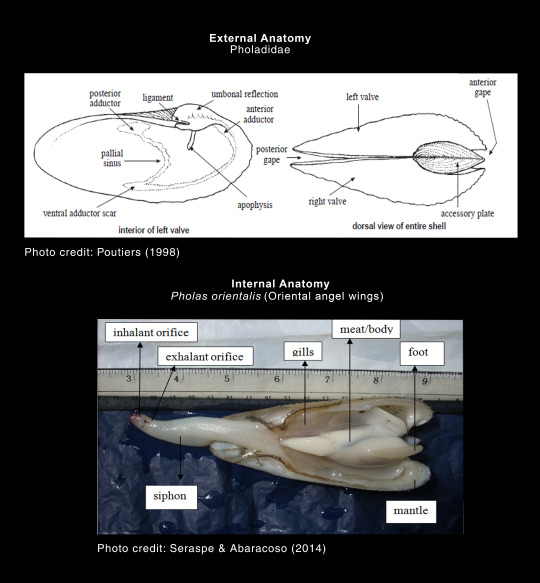
Like most bivalves, angel wings show bilateral symmetry. The common name was derived from the wing-like appearance of their shells. Shells are subequivalve, globular to elongated, and generally gaping anteriorly and posteriorly. Several accessory calcareous plates are seen on their main shell. The internal ligament is reduced and the main attachment point is by the muscles. Three adductor muscles have the jobs of pulling the shells close and opening it. The finger-like apophysis is where the foot muscles are attached. The mantle is fused ventrally with an exemption on the pedal, anterior gape. Twin bi-system siphons that protrude posteriorly are long and united, smooth and papillate. Gills that work as gas exchange surfaces are elongated with one to two branchial sheets. Foot tend to be circular, acting as a sucker (Poutiers, 1998).
Who Likes Boring?

The angel wings are highly specialized in boring into hard substrates. These substrates include rocky and woody structures in harbors and other coastal areas, in which some species are known for causing major destructions. Boring starts after settling as larvae, and deepening and enlarging the burrow as they grow. When boring, the valves are rocked sideways and contraction of the posterior adductor muscle results in the divergence of the valves in the front. The sucker-like foot takes a firm grip to pull the shell forward. The shells rotate a small angle by asymmetric contraction of the pedal retractor muscles and this continues. Viola! Their life-long tunnel is made (Morton & Morton, 1983; Poutiers, 1998).
The burrows serve as a form of protection from predators who dug them out of their homes such as humans. To eat, their twin bi-system siphons are extended outwards to filter feed on the water column. Microalgae and tiny zooplankton are the main sources of their diets. They use incurrent siphons to transport food into their bodies, and the waste products are excreted through their excurrent siphon. However, they do have a couple of competitors. These include sessile filter feeders (e.g. Mercenaria mercenaria) and other suspension feeders (e.g. bryozoans and polychaete worms) (Smithsonian Marine Station, n.d.; The Wildlife Trusts, n.d.).
Red + White = Happy Family

The sexes of the angel wing are usually not difficult to ascertain. The identifying attribute is the body's hue. While the males are milky white, female Oriental angel wings are reddish (Ng et al, 2009).
Oriental angel wings are simultaneous functional hermaphrodite. They slowly released both sperm and eggs from exhalant and inhalant siphons during spawning, but rarely from the posterior opening. Each spawner has a fertility rate of between 1 and 2 million eggs, depending on the size (Ronquillo and McKinley, 2006). During fertilization, swarms of sperm surrounded the egg (Ronquillo and McKinley, 2006).
“Humayo Kayo at Magpakarami”

(A) fertilized egg; (B) first cleavage; (C) second cleavage; (D) third cleavage; (E) fifth cleavage; (F) sixth cleavage; (G) seventh cleavage; (H) blastula; (I) gastrula; (J) early trochophore; (K) late trochophore; (L) early veliger; (M) late veliger; (N) pediveliger; (O) postlarva; (P) umbo; (Q) early juvenile; (R) late juvenile; (S) immature adult; (T) spawner. (Ronquillo and McKinley, 2006).
The first polar body (4 μm) was shaped 20 minutes later. Followed by the development of perivitelline membrane and (approx. 1 μm) perivitelline space within 38 min after spawning (Ronquillo and McKinley, 2006).

(a) Formation of the first polar body (b) First cleavage (c) Second cleavage (Ng et al, 2009)
The first indeterminate cleavage was observed after around 46 min. The first daughter cell increasingly protruded and expanded to around 20 μm in diameter. Then, a second cleavage was observed after 1 h 17 min post-spawning: the micromere split similarly and the macromere formed a daughter cell identical in size to the other two micromeres. The micromeres were localized in the animal pole as the cleavage progressed. Modified spiral cleavage and protostomic growth can be seen in embryos. Cilia emerged from the exterior surface of the individual blastomeres when the embryo entered the sixth cleavage stage. The embryo had a centrally positioned depression, 49 μm long, during the seventh cleavage. (Ronquillo and McKinley, 2006).

d) blastula, (e) Veliger, (f) D-hinged veligar (Ng et al, 2009)
The outline of the embryos became rounded during the closure of the blastopore and the movement shifted to a fast rotating movement that proceeded through the gastrula stage. The embryo shed off posterior cilia after approximately 11 h from spawning; the early trochophore stage was barrel-shaped with anterior velum lined with cilia. The early veliger formed a D-shaped shell (prodissoconch I) with bilobed velum, lined with cilia, after around 15 h 37 min. After 21 h and 50 min after spawning, the pediveliger with the expanded siphon and foot was observed crawling (Ronquillo and McKinley, 2006).

(g) Late D-shaped larvae, (h) early umbo stage, (i) Settlement stage (Ng et al, 2009)
The larvae reached the settlement stage at 23 h 10 min. After around 25 h, 99.7 percent of the D-hinge larvae (58.3 ± 0.3 μm shell length) emerged. It reaches the umbo stage after around 10 days of spawning (127.5 ± 0.5 μm shell length; 115.1 ± 0.5 μm shell width). Early juvenile stage (length of shell 1.046 mm; width of shell 0.701 mm) after 30 days (Ronquillo and McKinley, 2006).
RELATIONSHIP WITH HUMANS

(Segador, 2015)
Angel wing or diwal is of interest as a fishery commodity due to its savory taste. This type of clam is an economically important species found in intertidal areas of Western Visayas (WV). Diwal is considered to be a rare Ilonggo dish that could be served in different cooking styles such as baked, seasoned, and tinolang diwal. However, due to the high exploitation of diwal in WV years ago, this species was tagged to be threatened (Reyes, 2009).
Continuous efforts for managing the harvest of diwal in WV have been made in which some areas in WV were declared as “diwal sanctuaries”. A closed season from May to December was also imposed to conserve their population — giving ample time for these clams to reproduce and grow.
S. T. F. U.
Show The Facts Ugh!
Here are 5 important trivia and facts you need to know about Angel wing clam!
1. Are you my Angel?

Angels are for real! Angel wing clam is the common name given to the members of the family Pholadidae. Its name was derived from the wing-like appearance of the shell when fully opened (Wiggins, 2015). This feature is very fascinating and unique. Just make sure that the next time you see an angel wing clam, pray that your guardian angel isn’t that clam yet.
2. Blehhhh! 🤪

Angel wings clam are locally known as diwal. The term diwal means “sticking out the tongue” in Hiligaynon (Reyes, 2009). It seems that these angel-looking clams like to tease everyone with their tongue — their siphon rather.
3. Among us: Angelic Impostor edition

There’s an impostor among us! There are false angel wing shells that look very similar to true angel wings. The best way to spot the false angel wing is to look at the lacking spoon-like projection which is located below the beak of the real angel wing shell. False angel wings also have wider “feathers” on the anterior end of their shell (Mitchell, 2008).
4. Heaven's Menu

Before eating diwal, prepare yourself for a heavenly experience. Diwal is known for its soft, sweet, juicy, and succulent meat (Reyes, 2009). It is one of the best seafood to eat when visiting the WV region. Restaurants often serve it baked or steamed, or sometimes in a stew. The next time you visit WV, never miss the opportunity of trying this seafood from the heavens.
5. Not a Farewell, Just a “Til we meet again”

We may be enjoying this shellfish today, but Roxas City in Capiz, the seafood capital of the Philippines almost lost its prized shellfish due to overharvesting two decades ago. Through comprehensive rehabilitation program in 1997, the population of angel wing clam was saved from near extinction (Burgos, 2012).
References
Aqua Maps. (2019). Computer generated distribution maps for Pholas orientalis (Oriental angel wing), with modelled year 2050 native range map based on IPCC RCP8.5 emissions scenario [Photograph]. Available from: https://www.aquamaps.org/receive.php?type_of_map=regular
Burgos Jr, NP. (2012). Roxas’ prized shellfish makes a comeback. Inquirer Visayas. Retrieved from https://newsinfo.inquirer.net/158757/roxas-prized-shellfish-makes-a-comeback
ITIS. (n.d.). Pholas Linnaeus,1758. https://www.itis.gov/servlet/SingleRpt/SingleRpt?search_topic=TSN&search_value=81810#null
Laureta, L. V. , Marasigan, E. T. (2000). Habitat and reproductive biology of angelwings, Pholas orientalis (Gmelin). Journal Shellfish Research, 19(1): 19-22. https://www.researchgate.net/publication/287008755_Habitat_and_reproductive_biology_of_angelwings_Pholas_orientalis_Gmelin
Mitchell, PB. (2008). False Angel Wing: A Piddock for Your Thoughts. Retrieved from https://www.mitchellspublications.com/guides/shells/articles/0034/
Morton, B., & Morton, J. (1983). The Sea Shore Ecology of Hong Kong. Hong Kong University Press.
Ng, B. Tan, A. and Yasin, Z. (2009). Developmental stages, larval and post-larval growth of angelwing clam Pholas orientalis. WileyOnlineLibrary. doi:10.1111/j.1365-2109.2009.02177.x
Poutiers, J. M. (1998). Bivalves. In K. E. Carpenter & V. H. Niem (Eds.), FAO species identification guide for fishery purposes. The living marine resources of the Western Central Pacific. Volume 1. Seaweeds, corals, bivalves and gastropods. (pp.123-363). FAO
Reyes, G. (2009). Thank Heavens for Diwal (Angel Wings Clam). Experience Negros. Retrieved from: https://www.experiencenegros.com/diwal-angel-wings-clam/
Ronquillo, J. and McKinley, R. (2006). Developmental stages and potential mariculture for coastal rehabilitation of endangered Pacific angelwing clam, Pholas orientalis. Sciencedirect.com. doi:10.1016/j.aquaculture.2006.01.030
Segador, M. (2015). The ever famous Diwal shell (baked). Panay Island. http://panayisland.com/enjoying-sumptuous-seafood-feast-roxas-city/
Smithsonian Marine Station. (n.d.). Indian River Lagoon Species Inventory. Smithsonian Marine Station at Fort Pierce. Retrieved from: https://naturalhistory2.si.edu
The Wildlife Trusts. (n.d.). Piddock. https://www.wildlifetrusts.org/wildlife-explorer/marine/bivalves/piddock#:~:text=Piddocks%20are%20a%20boring%20bivalve,they%20glow%20in%20the%20dark!
Wiggins, C. (2015) Angel Wing Shell. Retrieved from http://conchology101.blogspot.com/p/angel-wing-////shell.
2 notes
·
View notes
Text
𝐑𝐞𝐥𝐞𝐚𝐬𝐞 𝐭𝐡𝐞 𝐊𝐫𝐚𝐤𝐞𝐧!
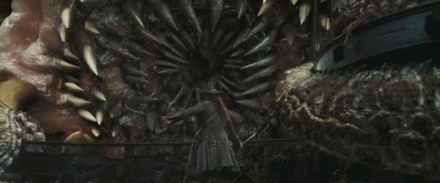
Have you ever seen this epic battle between Jack Sparrow and the legendary Kraken? Let’s meet the real-life origin of the horrifying Scandinavian mythological sea monster — the Giant Squid (Architeuthis).
CLASSIFICATION
Kingdom: Animalia
Subkingdom: Bilateria
Infrakingdom: Protostomia
Superphylum: Lophozoa
Phylum: Mollusca
Class: Cephalopoda
Subclass: Coleoidea
Superorder: Decabrachia
Order: Teuthida
Suborder: Oegopsina
Family: Architeuthidae
Genus: Architeuthis
Species: Architeuthis dux
(ITIS, nd)
BIOLOGY
A Global Sensation
youtube
Squids can be found in all the marine waters of the world, usually in continental and island slopes (see picture below). Some species occur in neritic and oceanic zones. However, salinity is a limiting factor for squids. In general, they prefer salinity concentrations between 27 and 37‰. They are also rare in tropical and high polar altitudes since colder temperatures are more favorable for them (Vaughan, 2000; Jereb et al., 2010).
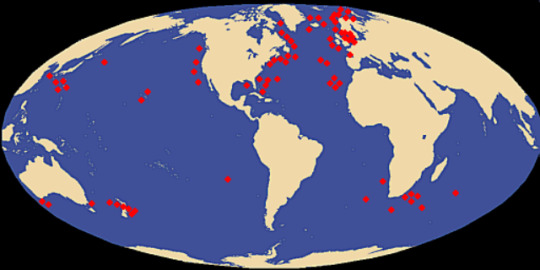
(Wikipedia Common, 2014)
Given these factors, many oceanic species undergo diel vertical migrations within 200 to 1000 m depth. During the daytime, their habitat range extends from 200 to 700 m with some deeper-living organisms at 600 to 1000 m depth. When nighttime comes, they ascend to the uppermost 200 m (Jereb et al., 2010).
Insides, Out!
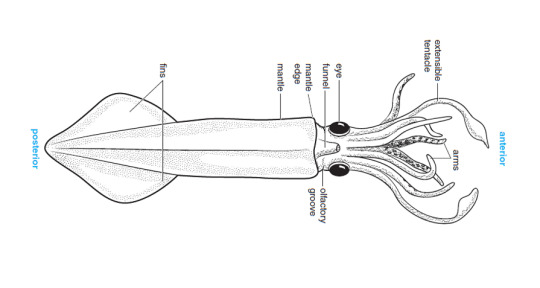
(Pechenik, 2015)
A squid can easily be distinguished by its external anatomy. The body is bilaterally symmetrical. It has an elongate, cylindrical, and soft body with fins on each side of the mantle (posterior end). The mantle covers the mantle cavity that houses the internal organs. Also, they have ten appendages (eight arms and two longer tentacles) stretching anteriorly from the head. These extremities have suckers or hooks, making them powerful tools in seizing prey (Jereb et al., 2010).
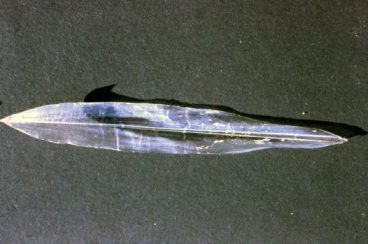
(Weaver, 2012)
Squids are under Phylum Mollusca, but its ancestral mollusk shell was reduced to the gladius or pen (see picture above). A pen is a chitinous structure usually rigid but others are thin and flexible. This loss led to the development of a strong muscular mantle that is very useful for fast swimming, specifically through the help of the funnel (Jereb et al., 2010).
youtube
The way they move is also the way they breathe! When squids respire, water goes into the dorsal mantle opening to the mantle cavity, bathes the pair of ctenidia (gills) with oxygenated water, and goes out through the funnel on its ventral side. The discharged water completes respiration, carries urine and metabolic wastes, and enables burst movement called jet propulsion. They also use their funnel for excreting ink (dark viscous fluid) and female reproductive products (eggs and egg masses) (Jereb et al., 2010).
youtube
With an active locomotory system, their circulatory system should be efficient. Squids have a close circulatory system with a systemic heart, two branchial hearts, and developed arteries, veins and capillaries that delivers blood to and from their muscles and organs. Aside from this, short bursts and escapes became more feasible because these organisms are ammoniotelic. They excrete ammonium ions (by the gill epithelium and renal appendages) to the surrounding water; thus, making it less dense (Jereb et al., 2010). The water is basically giving them a lift!

(Chokky, 2019)
Squids have a highly developed nervous system. In contrast with the molluscan nerve ring, they have a large brain and peripheral connections. They also have a remarkable vision. Their large eyes are comparable to a vertebrate, with a lens that focuses images on the retina. Moreover, the nervous system also has control over their ability to change colors. Chromatophores are pigment-filled sacs in the skin that can expand and contract. Controlling the size of these cells can lead to changes in color and even create patterns (Jereb et al., 2010).
Just Wanna Chill
Scientists believe that it is unlikely for a giant squid to survive in the tropics. In the warm waters, its blood cannot contain enough oxygen suffocating the squid. It will rise to the surface waters, but will not be able to dive and return to the deep. (Vaughan, 2000).
Away from Tsimosa’s
Most of the reproduction of giant squid is unclear. They are thought to replicate only once during their hypothetical life period of five years. In the posterior end of the mantle cavity, females have a single median ovary. Females develop a lot of eggs about 0.5-1.4 mm long and 0.3-0.7 mm wide weighing 5000 grams numbering millions. Then the eggs pass through paired, convoluted oviducts then exit via the oviducal glands, and large nidamental glands that produce substantial amount of gelatinous material (Vaughan, 2000).
Unlike other squids, a male giant squid do not use the hectocotylus to transfer sperm. Instead, the spermatophore is released from the penis and sticks out through the funnel. The male directly injects sperm packets into the arms of the female (Roper, 2018).
It is not known how the eggs are fertilized. Researchers hypothesize that the sperm will pass through her arms to internally fertilize the eggs or spermatophores now in the arms of the female will cause the ovaries to release jelly-bound eggs that she carries in her arms. Then the sperm senses the eggs nearby and migrates to fertilize the eggs in that direction.
Food Habits
youtube
While scientists did not observe a giant squid feeding, the stomachs of squids washed up on beaches were cut open to see what they had recently eaten. Giant squids often consume deep-water fish and other squids including their own kind. They will also attack schools of fish from below, rising rapidly into shallower waters to catch a meal before retreating away to safer depths (Roper, 2018).
By using their two long feeding tentacles, they capture their prey. To grip the prey, the tentacles are shot out. The suckers take hold of the prey on the tentacle tips and the tentacles contract, taking the prey to the arms. The arms then subdue the prey further, dragging it towards the big, sharp beaks. A huge collection of muscles operates the beaks that allow them to bite through just about anything that the squid might catch. But before being digested, the giant squid's bite-sized bits of food require more shredding. The tongue is fitted with an organ known as the radula, lined with thin, file-like rows of teeth. Before the tongue forces it down the esophagus to the digestive organs, the radula further shreds the meal (Vaughan, 2000).
A Calamari Buffet
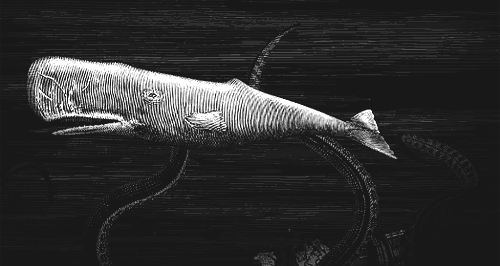
(Rebloggy, 2014)
The adult giant squid has very few predators. The sperm whale is the strongest and perhaps the only one. They have many predators, mainly deep sea fishes, as babies and juveniles. Once giant squids get past a certain size, they have outgrown the size of most of their possible predators (Vaughan, 2000).
In the stomachs of sperm whales, scientists have discovered beaks of giant squids. as well as other undigested bits of a giant squid . In addition, beach-stranded sperm whales were found with sucker marks on their skin, battle wounds large enough that they could only have been inflicted by a giant squid (Roper, 2018).
RELATIONSHIP WITH HUMANS
youtube
Humans have limited information about the giant squid as this mysterious cephalopod has kept its secrets well guarded. However, since the giant squid, like any other squid species, has a sophisticated nervous system and a large brain, scientists have shown great interest in studying this gigantic cephalopod (Marinebio, 2020).
Also, a giant squid's flesh is said to contain ammonium ions. These ions aid the animal in maintaining its buoyancy, particularly at greater depths like in the ocean’s twilight zone. Although the ammonium ions help the animal in its buoyancy, it gives its musculature a bitter taste which is inedible to humans— making this animal of no interest as a fishery commodity (Jeber & Roper, 2010).
Nevertheless, giant squids are considered keystone species in the deep-sea food web as deep-diving whales, e.g. sperm whales, prey on them.
WHAAAT THE FACTS!!
We have already been very much fascinated with this creature. But wait, there's more! We are yet to spill some teaaaaa 🍵! Here are four WHAT THE FACTS about Giant Squid that you should know!
1. It’s “SQUID”, not “squid”
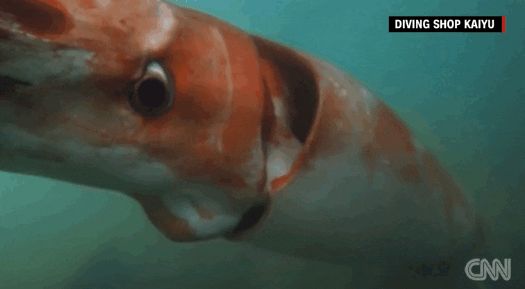
Giant squids are the largest invertebrates on Earth. According to evidences, giant squids can grow up to a maximum length of about 43 feet - about the same size of a regular bus. They also have gigantic eyes, about the size of a basketball, that allows them to see on their lightless deep-sea environment.
2. Not a coffee, but 3-in-1

Giant squids have three hearts. Like any other squid, giant squids also have a median heart that pumps oxygenated blood throughout the body, which it receives from two smaller ones that pump blood through the gills.
3. The BIGGER, the BETTER

For these creatures, size does matter. Giant squids are said to have penises that are about a yard long, no wonder female giant squids are bigger compared to male - to handle BIG troubles just in case love rings the bell.
4. Do not Dunk n' the Donut

For our last tea, we are serving it with a sweet treat -a giant squid's brain! The brain of a giant squid is donut-shaped. But it's not as fancy as you think. Its esophagus passes through the hole in the middle of its brain making every meal very critical for this creature. Unbroken pieces of food can rub against its brain and cause damage.
References
Chokky. (2019). Big Brain Markiplier [GIF]. Tenor. Available from: https://tenor.com/view/big-brain-markiplier-gif-14835823
ITIS. (n.d). Architeuthis dux Steenstrup in Harting, 1860. Available from: https://www.itis.gov/servlet/SingleRpt/SingleRpt?search_topic=TSN&search_value=556512#null
Jereb, P. & Roper, C. F. E. (eds). (2010). Cephalopods of the World. An annotated and illustrated catalogue of cephalopod species known to date. Volume 2. Myopsid and Oegopsid Squids. FAO Species Catalogue for Fishery Purposes. No. 4, Vol. 2. Rome, FAO. 605p. 10 colour plates.
Jereb, P., Roper, C. F. E., & Vecchione, M. (2010). Introduction. In: P. Jereb & C. F. E. Roper (Eds.), Cephalopods of the World (pp. 1-33). FAO.
Mancini, M. (2015). 20 Freaky Facts About the Giant Squid. Available from: https://www.mentalfloss.com/article/63719/20-freaky-facts-about-giant-squid
Marinebio. (2020). Giant Squid. https://marinebio.org/species/giant-squid/architeuthis-dux/
National Geographic Society. (n.d.). Giant squid. https://www.nationalgeographic.com/animals/invertebrates/g/giant-squid/
Rebloggy. (n.d.). Squid vs Whale [GIF]. Available from: http://rebloggy.com/post/gif-black-and-white-under-the-sea-squid-squid-vs-whale/92281691430
Pechenik, J. A. (2015). Biology of Invertebrates (7th ed.). McGraw-Hill Education.
Weaver, T. (2012). Pen of the extant squid Loligo by Dr. Isobell Bennett [Photograph]. NC Museum of Natural Sciences Research Blog. Available from: https://naturalsciencesresearch.wordpress.com/2012/06/11/some-cephalopods-inking-about-squid-pens/
Wikipedia Common. (2004). File:Architeuthis distribution.png. [Photograph]. Available from: https://commons.wikimedia.org/wiki/File:Architeuthis_distribution.png
7 notes
·
View notes
Text
𝐒𝐞𝐚 𝐇𝐚𝐫𝐞? 𝐒𝐞𝐞 𝐇𝐞𝐫𝐞!
LET’S PLAY!
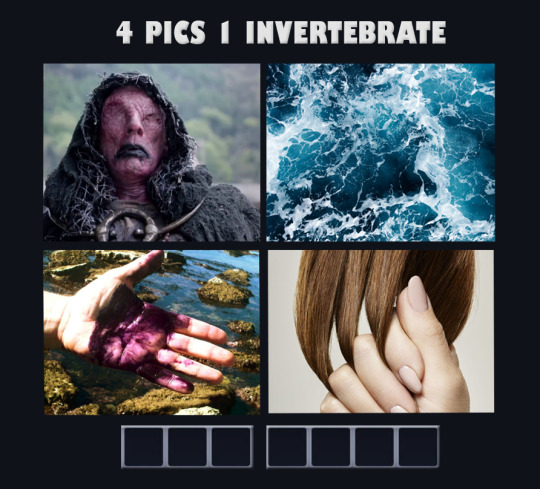
Get to know more about this invertebrate by reading this blog! It contains the classification, biology, relationship to humans, and interesting facts about this marvelous organism, specifically one of its subgroup — Aplysia.
CLASSIFICATION

Kingdom: Animalia
Subkingdom: Bilateria
Infrakingdom: Protostomia
Superphylum: Lophozoa
Phylum: Mollusca
Class: Gastropoda
Subclass: Opisthobranchia
Order: Anaspidea
Family: Aplysiidae
Genus: Aplysia
Species: Aplysia californica
(ITIS, n.d.)
Aplysia, commonly known as spotted sea hares, belongs to the group of gastropod molluscs. There are 37 known species in this genus. The word Aplysia came from the word L’Aplysia which means “that which one cannot wash”. They are one of the oldest mentioned animals from historical texts with the first authentic description provided by Pliny in his Historia Naturalis (published on 60 A.D) (Moroz, 2011) .
BIOLOGY
Ocean Globetrotters
These invertebrates are benthic dwellers that occupies the middle and lower intertidal zones, grazing on sea beds or corals. They are distributed in subtropical and tropical tide zones with one species (A. punctata) even reaching the Arctic Circle. Seven species of Aplysia can navigate long distances for example A. brasiliana which can travel up to 1 km in one swim episode (Moroz, 2011).
youtube
Spotted sea hares move in two ways, either by swimming or crawling on the sea bed. They swim by doing synchronized waves of muscular contraction pass from anterior to posterior to make a funnel that pulls in water, squeezing the anterior parts of the parapodia together forces the water out behind the creature and pushes it forward. While, they can crawl by raising the leading edge of the foot and extending it forward in an arching pattern so the rest of its body follows the arching pattern until it reaches the tail (Dice, 2014).
The Naked Alien
The body of spotted sea hares consists of a head, foot, and visceral mass. It is partially distorted, not coiled, and superficially bilaterally symmetrical (Fox, 2006).
The head has an anterior pair oral tentacles. The median union of the two tentacles forms a transverse oral veil over the mouth. A pair of rhinophores project dorsally from the surface of the neck. The oral tentacles and rhinophores serve as sensory organ. Specifically, their eyes are located at the base of each rhinophore (Fox, 2006).
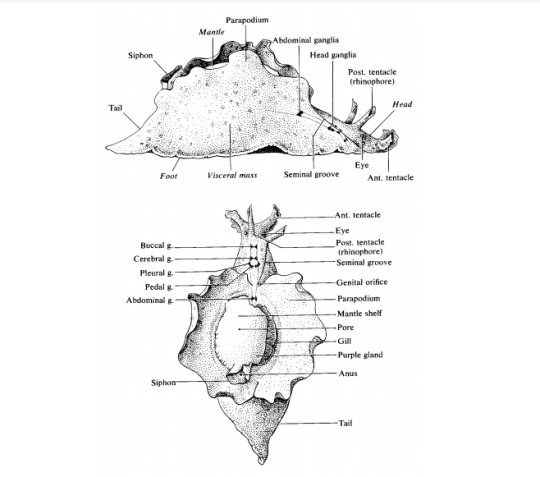
(Brooks & Hiller, 2001)
The foot lies along the midline of the ventral surface. Its posterior part serves as a sucker that is used to attach the posterior end of the animal while anterior end is elevated above the substratum. The foot extends posterior to the body as a short tail. Dorsolaterally, it is divided into two wing-like parapodia that is used for locomotion (Fox, 2006).

(Brooks & Hiller, 2001)
Their mantle and mantle cavity are found in the middle. The mantle is the dorsal body wall of the visceral mass. Inside it, the shell can be found. Below the shell is the reduced and small mantle cavity that opens broadly to the right containing the gill, anus, and gonopore. At the posterior right corner of the shell is a folded mantle resulting to a short, tubular, exhalant siphon that encloses the anus (Fox, 2006).
A Salad Lifestyle
youtube
Spotted sea hares feed on algae. A. californica (California sea hares) feeds on several kinds of red algae such as Laurencia pacifica, Plocamium pacificum and Ceramium spp. as well as sea lettuce and eelgrass. These organisms utilize their toothed radula to grasp the algae and store it briefly in the esophagus. Then, the food moves into the stomach fixed with pyramidal teeth to further crush the substances The food is blended in with different stomach-related digestive fluids to further breakdown the matter while the wastes are discharged out through the anus (Dice, 2014).
Dating on Another Level
Sea hares gather to mate. With the absence of dating apps, they find each other through tactile and chemical cues. They have photoreceptors that recognize fluctuations in the intensity of white light. Sadly, they find it hard to detect red wavelengths. To compensate, they respond more to chemical changes in seawater using the osphradium which detects dissolved chemicals in the water (Dice, 2014).
Loyalty, whomstve?
From a spiral cleavage to blastula, gastrula, trochophore and finally, the first larval stages — the development of their embryo happens inside the egg capsules. Newly hatch veligers swim upwards using their cilia and may take months drifting in the ocean while feeding on microscopic algae and bacteria until they detect cues that prompts them to settle to the alga which they will feed on. After this, they undergo rapid metamorphosis wherein they lose larval characteristics. They become juveniles that resemble miniature adults in all major features except reproductive organs (Moroz, 2011). California sea hares reach sexual maturity after about 120 days (Dice, 2014).
youtube
Sea hares are hermaphrodites, but they never self-fertilize by nature. Their copulation generally involves dozens. Every creature might be either getting or conveying sperm (or both) in respect of their present sex and position inside the chain (Dice, 2014).
Short Fruitful Years
Their life expectancy is normally short, most commonly survive for just a year. Many of them loose their life after reproduction. Amazingly, cool temperatures help delay reproduction; hence, cooler waters can fairly protract their life expectancy (Emore, 2002).
Hey, Leave Me Alone!
youtube
Distressed spotted sea hares secrete a purple ink which contains chemicals that disrupts the sensory function of opportunistic predators (Moroz, 2011). This chemical defense coupled with the distasteful algal toxins accumulated from their diet significantly creates a habitat where they can roam freely and has few natural predators (Emore, 2002).
RELATIONSHIP TO HUMANS
youtube
Sea hares are known to be highly valuable laboratory animals especially in the field of neurobiology, more specifically in studying memory and learning behaviors. The California Sea Hare (Aplysia californica) is an important neurobiological model and is used extensively in studies of behavior and psychology. They have the largest neurons in the animal kingdom making it feasible to identify the specific nerve cells responsible for certain mechanisms.
As for their ecosystem role, this herbivorous organism serves as keystone species in the intertidal ecosystem by affecting the density and abundance of its algal prey.
5 Interesting FYIs about SEA HARES
1. DUAL PURPOSE WINGS
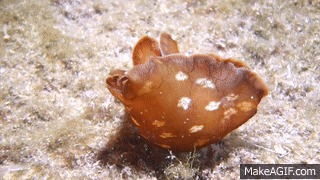
Sea hares have two large wing-like flaps that fold back on the body to protect their gills and internal shell plate. This wing-like extension is also used by some species of sea hares for short bursts of awkward swimming when threatened.
2. IT’S THE CIRCLE OF LIFE

As they say the more, the merrier. A circle of sea hares dubbed as a “Roman Circle” is formed during mating and copulation where each animal inseminates the one in front- a group sex indeed. As hermaphroditic organisms, sea hares serve as males at their front and females at their back.
3. GO AND MULTIPLY TO THE POWER OF 10

(Eleas, 2020)
Who cares about a twin, a quadruplet or a quintuplet? A single of this creature can lay up to 500 million eggs during one breeding season- that is more than a country’s population. Sea hares’ eggs are colored pink and often appear threaded.
4. WHAT YOU SEE, IS WHAT WE EAT
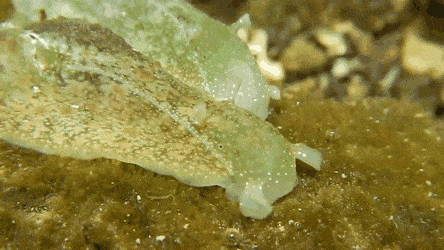
(Gfycat, 2019)
The color of sea hares are affected by the color of algae they consume. For example, young sea hares that tend to eat red algae are red in color, mature sea hares are colored green and brown because they consume algae that is also green and brown in color.
5. SEA HARES ARE CERTIFIED BTS STANS 💜 💜 💜
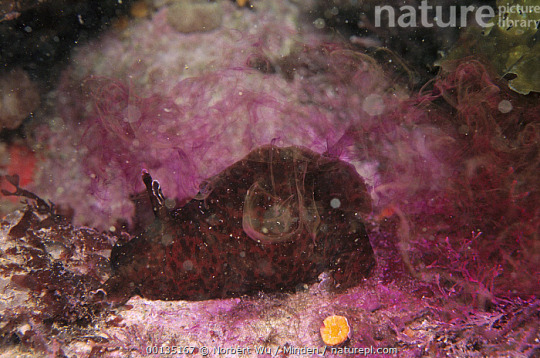
Sea hares have the right to use the infamous purple hearts on social media, and that’s a fact! This sea organism produces purple ink as a defense mechanism. Native Americans used this purple ink to dye clothing. Sea hares can also produce white or red ink depending on the color of the pigments in the seaweed they have consumed.

References
Angello, M. (n.d.). Full Frame Shot Of Sea Water [Photograph]. Getty Images. https://www.gettyimages.com/detail/photo/full-frame-shot-of-sea-water-royalty-free-image/730260985
Anonymous. (2017). Sea Hare Eggs [Photograph]. Ocean Safari Scuba. https://oceansafariscuba.com/photos/view_album/trip-11417-tidepool
Anonymous. (n.d.). Dinner Time with Sea Hares [GIF]. Gfycat. https://gfycat.com/unsteadydirectfreshwatereel-sea-hare
Brooks, R. & Hiller, J. (2001). The Role of Chemical Mechanisms in Neural Computation and Learning. [Photograph] .Research Gate. https://www.researchgate.net/publication/2524430_The_Role_of_Chemical_Mechanisms_in_Neural_Computation_and_Learning
Brown, C. (2010). Untitled [Photograph]. Flickr. https://inhabitat.com/wp-content/blogs.dir/1/files/2015/06/Sea-Hare-2-889x667.jpg
Dice, S. (2014). Aplysia californica. Animal Diversity Web. https://animaldiversity.org/accounts/Aplysia_californica/
Eleas. (2020). Naruto Clone GIF. Tenor. https://tenor.com/view/naruto-naruto-clone-funny-dancing-dance-gif-17857501
Emore, M. (2002). Aplysia dactylomela. Animal Diversity Web. https://animaldiversity.org/accounts/Aplysia_dactylomela/
Fox, R. (2006). Sea Hare. Lander University. http://lanwebs.lander.edu/faculty/rsfox/invertebrates/aplysia.html
ITIS. (n.d.). Aplysia californica J. G. Cooper, 1863. ITIS.gov. https://www.itis.gov/servlet/SingleRpt/SingleRpt?search_topic=TSN&search_value=78032#null
Moroz, L. (2011).Aplysia. NCBI. https://www.ncbi.nlm.nih.gov/pmc/articles/PMC4024469/
12 notes
·
View notes